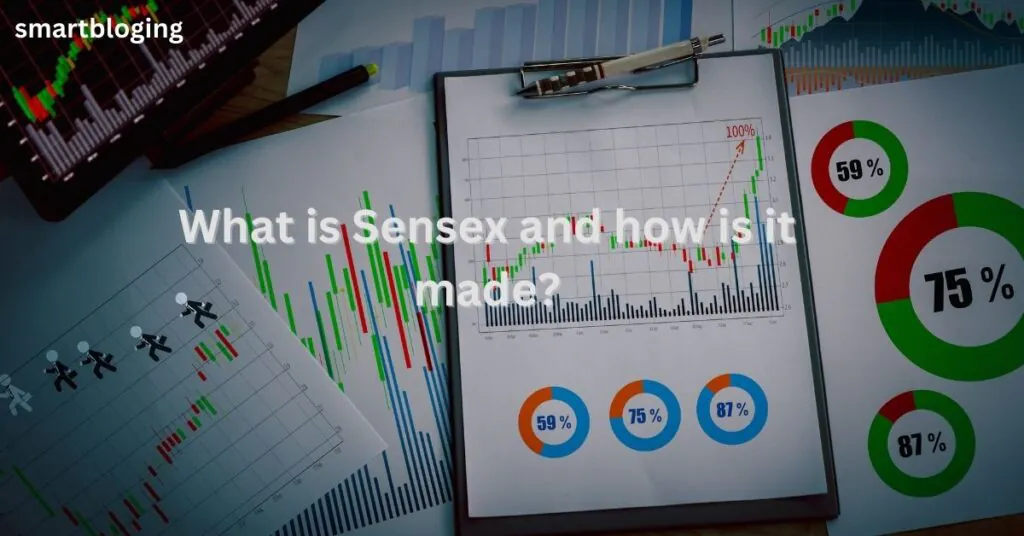What is Sensex and how is it made?- Sensitive Index, or Sensex, is a Bombay Stock Exchange (BSE) stock market index that tracks the performance of the top 30 BSE-listed companies. It is one of the most widely used stock market indices in India and gives a good indication of how the Indian stock market is doing overall. Using a free-float market capitalization weighted formula, the index is determined.
What is Sensex and how is it made?

History of Sensex
Sensex had a base value of 100 when it was first introduced in 1986. It was started to give investors a general idea of the market and to evaluate the performance of the Indian stock market as a whole. Since its inception, the index has advanced significantly and experienced many ups and downs. From a starting value of 100 in 1979 to more than 60,000 in 2021, it has increased.
Components of Sensex
The largest and busiest companies on the BSE are represented by the 30 companies that make up the Sensex. Based on their market capitalization, trading volume, and other considerations, these businesses were selected. The Sensex includes well-known companies like Reliance Industries, HDFC Bank, Infosys, and Tata Consultancy Services.
Calculation of Sensex
The free-float market capitalization weighted method is used to determine the value of the Sensex. The market value of all the shares of every company listed on the BSE is considered, and the free-float adjustment is made. Shares held by promoters, governments, or other entities are not included in the term “free-float,” which refers to shares that are easily exchangeable on the market. The formula used to determine the index is as follows: Sensex = (Total Market Value / Base Value) x 100.
Market Capitalization and Sensex
The total market value of a company’s outstanding shares is referred to as market capitalization. It is one of the criteria used to calculate a company’s weight in the Sensex. A company has a higher weight in the index the higher its market capitalization. The market capitalization of the top 30 companies listed on the BSE is thus reflected in the Sensex.’
Role of Sensex in Indian Economy
Sensex is essential to the Indian economy because it measures the health of the stock market as a whole. It is a crucial metric for gauging investor sentiment and national economic expansion. A rising Sensex denotes a bullish trend, while a falling Sensex denotes a bearish outlook for the stock market and the economy. As a result, it is closely watched by traders, investors, and decision-makers.
Factors Affecting Sensex
The performance of the Sensex can be influenced by a number of variables, such as interest rates, political developments, global economic conditions, and corporate earnings. The index may be impacted by any event that has an impact on the performance of the underlying companies. For instance, a company’s positive earnings report may cause its stock price to increase, which will have an effect on the Sensex.
Importance of Sensex for Investors
Sensex is a crucial tool for investors because it gives them a general idea of the performance of the stock market. Investors are given the tools they need to plan their investments and are assisted in making informed investment decisions. Additionally, it gives them a benchmark by which to compare the performance of their own investments.
Also Read: What is Zika Virus and how to avoid it?
Sensex Performance Indicators
The Indian stock market’s performance is measured by the Sensex. Additionally, it serves as a standard by which the effectiveness of mutual funds and other investment vehicles is evaluated. The Sensex’s returns are frequently used as a proxy for the performance of the Indian stock market as a whole.
Risks Associated with Sensex
The Sensex is no different from other stock market investments in that it entails inherent risks. The index’s performance is dependent on a number of variables, including business performance, political developments, and economic conditions. As a result, before buying stocks, investors should use caution and do their homework.
Future of Sensex
Given that the Indian economy is predicted to grow steadily over the next few years, the Sensex’s future appears promising. As a result, investors will probably have access to a variety of investment opportunities on the stock market, and the Sensex is anticipated to continue serving as a gauge of the market’s health.
Conclusion
Given that it offers a summary of the stock market’s performance, the Sensex is an essential tool for investors, traders, and policymakers. It provides insight into the state of the economy as a whole and is very important in determining investor sentiment. The Sensex offers investors a benchmark against which they can compare their own investment performance even though stock market investing entails inherent risks. As a result, it is a crucial sign of India’s economic expansion and investor confidence.